Text
Well the plan was to get Prince of Shadows out over last weekend, but it ended up turning into a bigger rewrite than I had anticipated and other priorities came up. Still on the near horizon though, and I'm really liking the changes so far, so I can't complain too much.
6 notes
·
View notes
Text
REBLOG if you have amazing, talented WRITER friends.
Because I certainly do, and I love every single one of them and their work.
195K notes
·
View notes
Text
Working on the first little story I want to put on here. It's going to be a rewrite of something I wrote for a creative writing class in college that I really liked. My goal is to hopefully put it out this weekend or sometime next week if that doesn't work out, this week's work schedule has been a little crazy haha. So look forward to The Prince of Shadows!
0 notes
Text
No one can be more cruel to you than yourself, and no one else's kindness matters more.
0 notes
Text
Writing advice that changed my sentence
When I was a young writer, I was told that I often started my sentences with "there is/there was/there are." I was told to eliminate those as much as possible.
I couldn't believe how often I used them. My first novel was completely littered with them.
I learned to diversify and grow my use of verbs. Instead of the state-of-being verbs, like "is" which isn't very descriptive at all, I started using stronger verbs.
Instead of writing "There were a bunch of trees on the hill" I wrote "A cluster of trees towered over the hill."
"Towered" is a much stronger verb than "Is"
Use the state-of-being words, but if you can, try replacing them with more active verbs. You might be surprised how much your writing improves.
12K notes
·
View notes
Text
The Creator's Compendium
Welcome to the Compendium! This is where I post original writing, in particular my short story series Addorhia Stories. I'll probably also include other writings and series in the future, such as one offs like Highlander's Daughter. I intend for most of my original works to be free for a time on AO3 until I turn them into a collection.
I also post whatever comes to mind. Whether that has to do with writing, reblogging content, games, streams (which I plan to do on occasion), or whatever else.
0 notes
Text
Redstone for Writers and Artists Part 1: The Basics
Very long post ahead peeps. I tried to put just...as much information as I would want to refer to if I was writing a redstone mechanic into a fic, so. Here it is, along with future links to the other two posts [or three posts, depending on how many questions I get] and the Google Form to send in questions. <3

Let's start with the basics - Redstone dust, or as it will look for the rest of these posts -
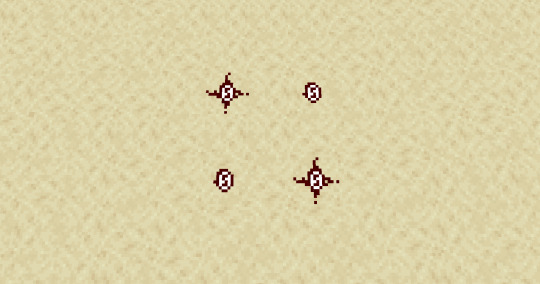
I'm using Vanilla Tweaks resource pack addons to make all of the redstone stuff easily visible for the purposes of explaining. the mechanics. The reason there's a big 0 in the middle is because, as you may or may not know, redstone power can only travel 15 blocks before it has to be re-strengthened. Think of redstone dust as the wiring for an electrical component.
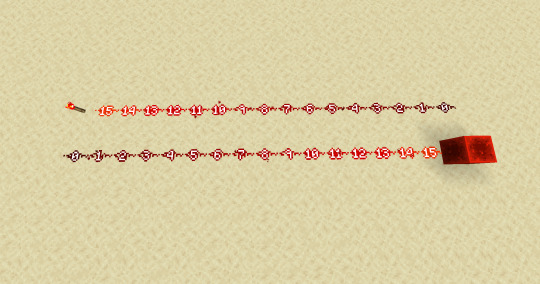
Here I demonstrate the distance redstone dust can be powered using both a Redstone Torch and a Redstone Block
A Redstone Block is a permanently on power source for redstone.
A Redstone Torch is a power source for redstone that outputs level 15 power and can both be toggled off and burn out, as shown below. The reason the torch burns out is because the redstone is activating and deactivating the blocks around it too quickly [8 times in ~3 seconds].
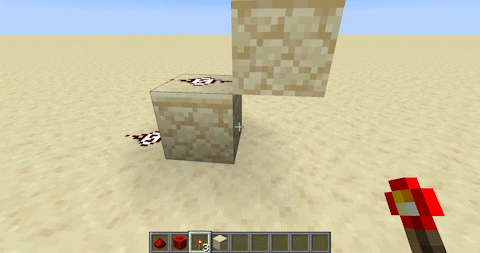
This image helps to show what's going on. The bottom torch is attached to an 'off state' block [the powered off redstone lamp] so it can be in an 'on state'. That torch then powers the block above it into an 'on state' [the powered redstone lamp] which then sends a redstone signal to the torch attached to it to put it in an 'off state'. This is one method to power redstone vertically. In the above video, the blocks surrounding the torch are cycling through these on and off states too quickly, causing the torch to burn out.
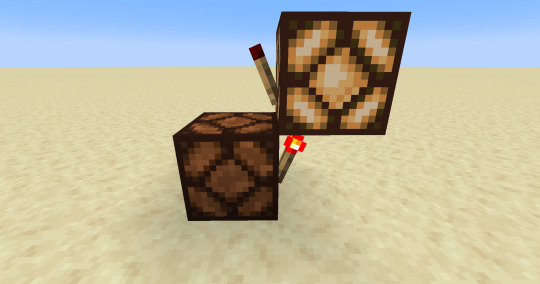
The next thing to cover is the Redstone Repeater. This little doohickey has 4 different states: a 1, 2, 3, and 4 tick delay, as seen from both the back and side in the below images. A Tick is a measurement of time in Minecraft, defined as 0.1 second for redstone purposes. The repeater puts out a redstone power level of 15 regardless of how strong the power going into it is.

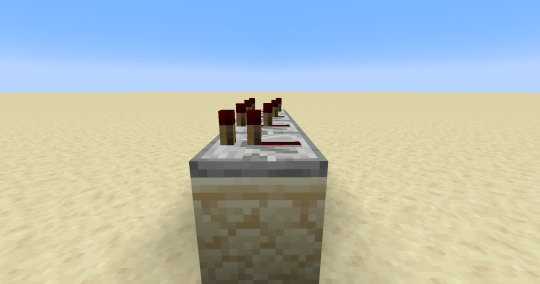

In comparison, a Redstone Comparator maintains the signal stretch coming out of it. As seen below, when comparators are used in place of repeaters, the line no longer full powers.

Comparators can also be used to read the fullness of containers like chests. It's a little hard to see in the video [since I only have 1 computer and 1 account, I can't film this from two angles] but in the right-hand side you can see the redstone number ticking up as more items enter the chest.
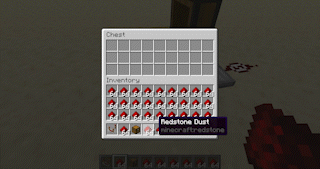
Next up, Pressure Plates. There are 4 different kinds of pressure plates in the game - Stone [and blackstone], Light Weighted, Heavy Weighted, and Wooden.
A Wooden pressure plate is a standard pressure plate - drop an item on it, stand on it, or get a mob to stand on it and it will turn on to a power level of 15
A Light Weighted Pressure plate [gold] recognizes all entities but it ticks the number it outputs up by 1 every time there is another entity on it.
A Heavy Weighted Pressure Plate [iron] recognizes all entities but it ticks the number it outputs up by 1 every 10 entities.
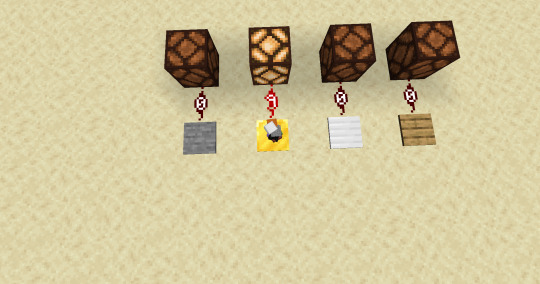
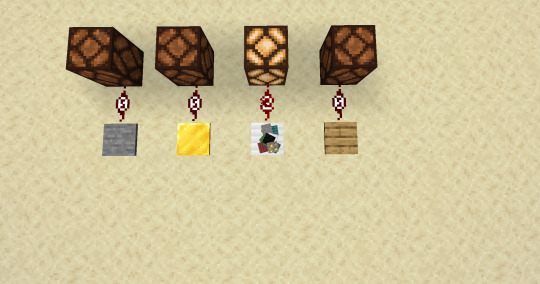
[for reference, in the above image there are 9 items on the gold pressure plate and 11 [bc the first 10 count at '1'] on the iron pressure plate]
A Stone pressure plate only recognizes Players and Mobs, not Entities, but when activated also puts out a power level of 15.
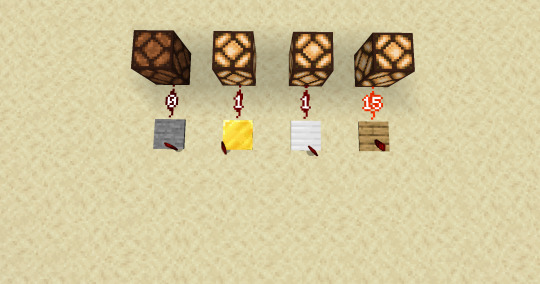
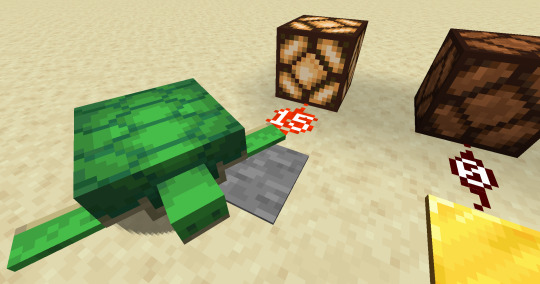
Onto Buttons and Levers. In Minecraft, there are two kinds of buttons, Stone and Wood. The main different between them is that a Stone button is depressed for 1 second whereas a Wooden button is depressed for 1.5 seconds. The other difference between the two button types is that Wooden buttons can be interacted with by Arrows and Tridents but a stone button cannot. If you shoot a wooden button, it stays depressed until the arrow or trident despawns. A lever can be flicked on and off to act as a switch for a minecraft circuit.
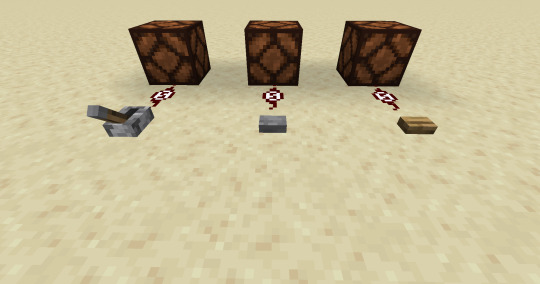
Other methods of outputting a redstone signal include things such as:
Turning a page in a book on a Lectern[it involves some very complicated math so just know the more pages a book has, the weaker the signal it puts out so you have to flip more pages to output a stronger signal][a book with 1 page outputs a level 15 signal, a book with 15 pages outputs a level 1 signal on page 1 and a level 15 signal on page 15]
Being in the vicinity of a Sculk Sensor [the closer you are when it triggers, the higher the power level it outputs],
Shooting a Target Block[Most projectiles output a signal for 0.4 seconds, whereas an arrow or trident output for 1 second, and the closer the projectile hits to the center the higher the power level it outputs]
A Daylight Detector changes its signal strength based on the time of day, whereat noon it is a full strength signal and it goes down in eithe direction from there. A daylight sensor can also be reversed, wherein it checks for darkness and at Midnight outputs a signal strength of 11 [because of how the game checks the internal skybox] [I am not gonna lie to you. It is more complicated than this. Just know that if its cloudy or raining or storming the signal strength weakens. We're not actually building redstone mechanisms here]
A Lightning Rod outputs a level 15 signal when struck by lightning
A Tripwire acts as a pressure plate if there are tripwire hooks to either side of it. They output their signal into the block they are attached to.
Pistons and Sticky Pistons are fairly simple contraptions. They can push blocks and entities, and sticky pistons can then also pull them back. This list tells you everything a piston cannot push or pull though. We're writing fanfiction and drawing fanart with this information and I tend to...ignore it at my whimsy. There is a very popular mod which a lot of the Hermits have used in their one off videos that allow pistons to interact with containers, for example.
Related to Pistons are Honey and Slime blocks. Functionally these items are identical. They can be pushed by pistons and sticky pistons, and any blocks stuck to their sides will come with them. They do not stick to each other, so they're often used for making things like doors and flying machines[which are redstone mechanisms that move themselves, generally used for more complicated machinery] Below they are combined with sticky pistons in order to move back and forth.
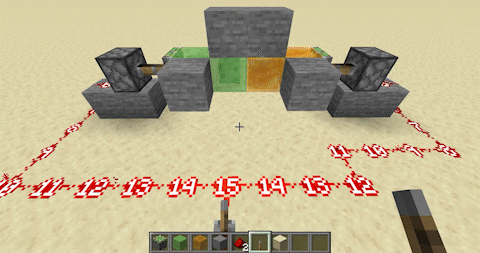
Dispensers and Droppers are both items that can disperse entities into the game. The difference here is that Droppers will always spit out the item and Dispensers can dispense certain items like water [seen below], lava, arrows, and eggs, along with placing Shulkers. Droppers can deposit items into containers directly infront of them, including other Droppers, and make a thing known as a dropper pipe to move items around in a system. You can remember which one is which because a Dispenser looks like an :O face whereas a Dropper looks like a :> face.
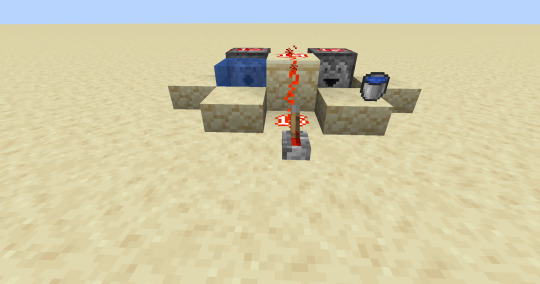
Hoppers are containers that can pull items from containers above them and push them into other containers. They can receive a redstone signal in order to 'lock' them and keep from moving items around. <- More information about these specifically will be in the Adjacents post.
Trapped Chests are containers that output a redstone signal when they are open. If you place a trapped chest on top of a hopper, the hopper wont pull items until you close the chest. This can also be used to effectively make traps, hence the name 'Trapped' chest.
Observers are a block which can observe changes to blocks in front of them. The little face on an observer is where it's 'looking', and the little red dot on the back of an observer is where it outputs the redstone signal based on the changes it observes. This list tells you what an observer can and cannot detect, though I also play fast and loose with this list as I need to.
And that about wraps it up for the basics. Don't see what you were hoping to see in this post? In the next day [hopefully] I will be doing Redstone Adjacent and Lore posts. Adjacents are things like 'Why do Redstoners use so much wool?','How do minecarts interact with Redstone?', and other fun tips and tricks. Lore will...honestly be mostly self-indulgent fanlore I've either come up with or observed over the years such as 'Redstone is spicy pop rocks', 'Redstone is Radioactive', and 'Redstone is older than the ancients'. That still doesn't cover it? Feel free to send in any of your questions about Redstone to my lovely google form and I'll be making a follow up post answering anything I think isn't answered within the posts!!
Part 2: The Adjacents can be found here
Part 3: The Lore coming soon!
Taglist below - DM or inbox me to be added!
@atherix @braxiatel @greatbridge @ellalily @lesbianwilby @em-mermaid @loombarrow @sparksnevadas @aceofthefandoms
301 notes
·
View notes
Text
The Ultimate Creative Writing Resource List
After writing for quite nearly my entire literate life ~and~ getting a creative writing degree, I've put together a comprehensive list of the sites and blogs that I've found most useful! Check it out, we've got—
An Insanely Detailed Character Creation Sheet: use this page to learn everything you've ever wanted to know about your character and more. It never fails to make me consider something about them I wouldn't have thought of otherwise.
A Character Avatar Creator: if you know what your character looks like and want a visual of them for notes/cork boards/Google Docs, this site will let you personalize them almost as much as a Sims game.
Pinterest: if you don't know what your character looks like and need inspiration, search for pictures of people who inspire you. Definitely have done this more often than not because I can never seem to pin down (pun intended) my character's exact appearance. Really helps with things you might forget while writing, like the shape of their eyebrows, how their hair lays or even how they stand.
A Map Creation Website: it's meant for fantasy worlds but I've used it for my historical fiction novels! Super customizable even without paying for it. It also saves your work in the free version, which has saved me when I forgot to upload copies to where I keep all my story stuff.
Grammar Girl: have any questions about where to put that semicolon or when to use italics? Grammar Girl is literally used by English teachers because it's that accurate. Check your work or put as many commas in that manuscript as your heart tells you to anyway. I've done both!
Grammarly: this is another way to check your grammar, especially if you use the Chrome extension. It automatically checks your basic grammar, spelling, and readability while you type in Google Docs or another browser-based text document. Note that it isn't foolproof and sometimes will suggest things that don't make sense. Use your best judgement when it highlights things!
Word Hippo: do you feel like you've used one word too often in your story? I use Word Hippo daily for both my creative and professional writing to avoid repetition. When I can't think of a synonym or antonym on my own, it has a billion suggestions for adjectives, verbs, nouns, etc. It can even help you find words that rhyme! Make your character a poet. Nothing can stop you.
Text-to-Speech Reader: it's always easier to catch minor line errors when you read something out loud, but if you don't feel like doing that, this site will read your story for you. There are multiple voices to choose from, so have fun listening to your hard-won stories while you edit.
Background Noise—Coffee Shop: I always lose myself in stories when I have this video playing in the background. It's like I'm in a coffee shop or cozy restaurant booth, but without spending money.
Background Noise—Tavern Fireplace: same vibes as a coffee shop, but with fireplace crackling.
Background Noise—Rain Shower: listen to rain patter against your window with some thunder in the background.
Background Noise—Cozy Fireplace and Rain Shower: combine your favorite sounds in this extra long video of a wood-burning fireplace and a distance rain shower. Perfect for anyone who doesn't want to hear extra loud thunder.
Background Noise—Forest Sounds: is your story taking place outdoors? These sounds will make you feel like you're in the woods with your characters.
Background Noise—Blizzard Sounds: constant blizzard winds may easily make you feel removed from the world so you can focus on your work.
Background Noise—Interior Plane Cabin White Noise: the pleasant hum of a plane cabin is what I often write to. There are no loud take-off, landing, or passenger sounds either.
Background Noise—Christmas Music From Another Room: I found this video when quarantining for Christmas with my husband in 2020. It ended up being one of my favorite writing background videos of that year. It features lyric-less songs on vinyl, plus muffled talking, which was a definite perk for the year+ we spent inside.
Background Noise—Lo-Fi: when I'm not sure what I want to write to, I use this playlist. It has the perfect low-key beats for writing less-intense scenes or working on plot, characters, mapping, etc.
Tumblrs With Fantastic Writing Tips: I have a few favorite tumblrs I loooooove and have followed on various blogs for many years. They regularly answer submitted questions and have organized tags, so if you're wondering about something, you'll likely find an answer by searching their blogs! Check out @fixyourwritinghabits @heywriters @wordsnstuff for expert-level help, guidance, and inspiration.
Tumblrs With Writing Prompts: while there are many prompt websites and blogs, my favorite prompt tumblrs are @daily-prompts and @creativepromptsforwriting for their variety and creativity!
Other resources...
Goodreads: consistently reading is part of exercising that creative muscle in your brain. Goodreads will help you keep track of everything you've read, are reading, and want to read. Find your next inspiration and the latest updates on what's coming out soon from your favorite authors.
Poets & Writers Contests: this site is always posting the latest creative writing contests for all genres. It also has free submissions, so don't worry if you can't afford entry fees for now.
The Writer: you'll also find great contests (both free and paid) at The Writer. Explore their site to discover other great resources too, like writing getaways and publishing tips.
---
Enjoy and I hope this helps! Feel free to reblog and add other resources that you use for your writing. I'd love to find more!
4K notes
·
View notes
Text
Tip #3
Take notes!
Whether you are a meticulous outliner or a writer who keeps everything in their head, taking notes can be a life-saver.
Take notes while you write. Take notes while you edit. Because no matter how good you are, you will forget whether you've been formatting the time as 3PM or three PM. You will forget how many roommates your protagonist's best friend has. You will forget what day of the week an event took place, and what streets side characters live on, and what food a character off-handedly mentioned they hated. You will forget the little things and, if your story is long enough, you will forget the big things, too.
So instead of wasting time scrolling through your 300 page Word document or pouring through word search results, take notes! They will make the writing and editing experiences much easier, and ultimately much more fun.
139 notes
·
View notes
Text
Six Ways To End Your Story
Hi, everyone! Someone kindly asked for advice on how to end a story so here it is for everyone!
Six Types of Story Endings
While every story has to end its own way, there are six general types of ending. Which one you go for will depend, of course, on the story you’re telling, and maybe also on the tropes or conventions of the genre you’re working within (if you’re working within a genre at all).
The six types of story endings include:
Resolved ending
Unresolved ending
Expanded ending
Unexpected ending
Ambiguous ending
Tied ending
What Is a Resolved Ending?
A resolved ending leaves the reader with no lingering questions or loose ends A resolved ending is part of most classic fairy tales (“And they all lived happily ever after…”), but also of countless classic novels.
Consider the ending of Jane Austen’s Pride and Prejudice, a classic of literary fiction and the inspiration for countless romance novels. At the end of the book, Elizabeth Bennet and Mr. Darcy marry, and we’re led to believe that their marriage will be long and happy. Not only that, but the rest of Mr. Bennet’s marriageable daughters have settled down in matches appropriate to their characters. In other words, there are no lingering questions or tensions.
Remember, a resolved ending isn’t necessarily a happy ending. Think of any of Shakespeare’s tragedies, in which the protagonist and most of the other major characters usually wind up stabbed, poisoned, or executed.
What matters most in a resolved ending is that all of the threads of the novel have been clearly and satisfying resolved.
What Is an Unresolved Ending?
Sometimes, the end is not really the end. That’s the case with an unresolved ending. This is the kind of ending that leaves the reader with more questions than answers. Ending on a cliffhanger has the potential to be a frustrating experience, but that frustration can also be satisfying if the story calls for it.
Unresolved endings are popular choices for books in a series, because it leads the reader to the next book.
What Is an Expanded Ending?
An expanded ending often takes the form of an epilogue. As the name implies, it expands the world of the story beyond the events of the narrative itself. That usually involves a jump forward in time, and occasionally a change in perspective as well. (Dostoevsky’s classic Crime and Punishment ends on just such a note, as does Tolstoy’s War and Peace.) Like an unexpected ending, an expanded ending may reframe the way the reader has been thinking about the story.
One advantage of an epilogue is that it allows the writer to answer questions that might not be possible to answer in the space of the main narrative (for instance, how things turned out a decade or more after the main events of the story).
What Is an Unexpected Ending?
An unexpected ending is one the reader likely didn’t see coming. The twist ending can be earth-shattering, or clever and subtle. The trick to pulling off a great surprise is that it should seem inevitable in hindsight. Very few readers are likely to be on board for an ending that seems to truly come from nowhere, but if the ending makes sense they’re more likely to appreciate the subtle machinations and plot twists it took to get there.
A good ending avoids deus ex machina, a Latin expression meaning “god from a machine.” In the context of fiction, a deus ex machina is a heavy-handed device that abruptly and definitively resolves all the story’s problems in a way that doesn’t feel natural to the story.
For instance, a previously unknown rich uncle appearing from nowhere to give the poor striving protagonist a vast fortune may certainly be a surprise, but it’s not likely to satisfy your readers. Remember, a good twist is one that the writer has left clues for all along.
What Is an Ambiguous Ending?
An ambiguous ending is one that’s open to interpretation. While an unresolved ending doesn’t give the reader enough information to say what’s going to happen next, and an ambiguous ending might allow two different readers to come to two completely different conclusions. Of all the endings, the ambiguous one demands the most involvement from the reader, since they are actively invited to think about the significance of events for themselves.
Take a quick look at the ending to Charles Dickens’ classic Great Expectations. In the last lines of the novel, the main character Pip takes the hand of the widow Estrella and says he sees “no shadow of another parting from her.” But is Pip’s vision reliable? Do they stay together or is another parting in the future? The novel leaves the reader with both tantalizing possibilities.
What Is a Tied Ending?
A tied ending is on that brings the story full circle—it ends where it begins. This type of ending follows the classic Hero’s Journey, which is common to many myths and folktales from around the world, but it’s also a popular choice for many works of literary fiction trying to capture the cyclical nature of time. James Joyce’s famously beguiling Finnegan’s Wake even ends on a sentence fragment that literally completes the very first sentence of the novel.
As a writer, you’ll need to make sure that the journey to this point felt worthwhile. Ending up right where you started can feel pointless if the journey there and back wasn’t meaningful.
There you have it folks, and kind ask, I hope this helps anyone who is struggling with their story endings!
Follow, reblog and comment if you find these helpful!
2K notes
·
View notes
